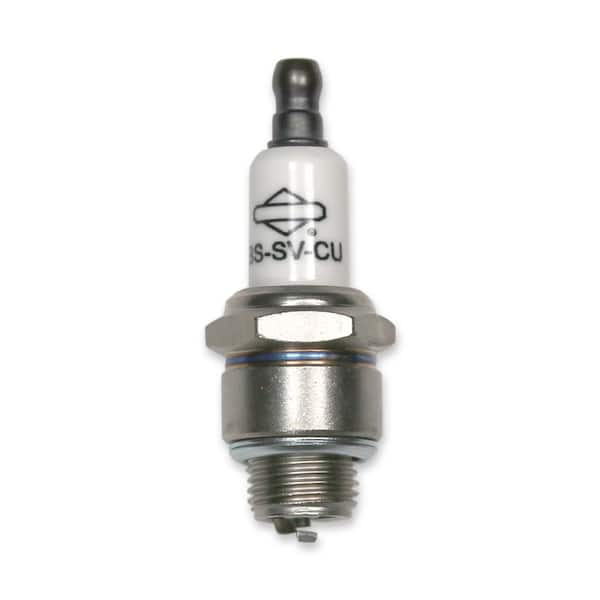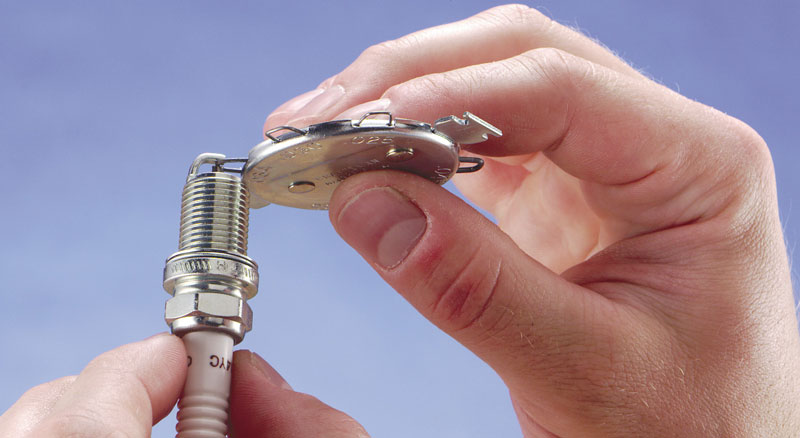For a Briggs and Stratton engine, the spark plug gap should be set at 0.030 inches. Proper gap ensures optimal engine performance and ignition efficiency.
When the gap is too wide or narrow, it can lead to misfires and poor engine operation. Correct gap setting is crucial for smooth engine start-up and overall performance. By adjusting the spark plug gap to the manufacturer’s specifications, you can maintain your engine’s reliability and longevity.
Be sure to check and adjust the gap regularly to keep your Briggs and Stratton engine running smoothly.

Credit: www.homedepot.com
Contents
What is a Spark Plug Gap?
The spark plug gap is the distance between the center electrode and the ground electrode of a spark plug. When the spark plug fires, an electrical spark jumps across this gap to ignite the air-fuel mixture inside the engine’s cylinder. The size of the gap is crucial for ensuring that the spark is strong enough to ignite the mixture efficiently.
A gap that’s too small may produce a weak spark, leading to poor combustion and reduced engine performance. Conversely, a gap that’s too large may require more voltage to create a spark, potentially leading to misfires and engine issues.
Importance of Proper Spark Plug Gap
The correct spark plug gap is vital for several reasons:
- Optimal Combustion: The right gap ensures that the spark is strong enough to ignite the air-fuel mixture efficiently, leading to complete combustion and better engine performance.
- Fuel Efficiency: A properly gapped spark plug helps the engine burn fuel more efficiently, improving fuel economy and reducing emissions.
- Smooth Engine Operation: Correctly gapped spark plugs contribute to smoother engine operation, reducing the likelihood of misfires, rough idling, and starting problems.
- Extended Engine Life: Consistent and reliable ignition reduces stress on the engine, potentially extending its lifespan.
Spark Plug Gap for Briggs And Stratton Engine
Briggs & Stratton engines typically require a spark plug gap of 0.020 to 0.030 inches (0.50 to 0.76 mm). However, the exact gap can vary depending on the specific engine model. It’s crucial to consult your engine’s manual or the manufacturer’s specifications to determine the correct gap for your engine.
Here are some general guidelines:
- Small Engine Models: Many small Briggs & Stratton engines, such as those used in lawnmowers, typically require a gap of 0.030 inches (0.76 mm).
- Larger Engine Models: Some larger engines, such as those used in generators or pressure washers, may require a gap of 0.025 inches (0.64 mm).
How to Measure and Adjust the Spark Plug Gap
Measuring and adjusting the spark plug gap is a straightforward process that requires a few simple tools:
Tools You’ll Need:
- Feeler Gauge: A feeler gauge is a tool used to measure the gap between two surfaces. It consists of multiple metal blades of varying thicknesses.
- Spark Plug Gapping Tool: This tool is used to adjust the gap by carefully bending the ground electrode.
Steps to Measure the Gap:
- Remove the Spark Plug: Use a spark plug socket and wrench to remove the spark plug from the engine. Be sure to disconnect the spark plug wire before removing the plug.
- Inspect the Spark Plug: Before measuring the gap, inspect the spark plug for signs of wear, carbon buildup, or damage. If the spark plug is worn out or damaged, it’s best to replace it.
- Measure the Gap: Insert the appropriate blade of the feeler gauge between the center and ground electrodes. The blade should fit snugly with a slight drag. If the blade is too tight or too loose, the gap needs adjustment.
- Adjust the Gap (if necessary): If the gap is not within the recommended range, use the spark plug gapping tool to gently bend the ground electrode to the correct distance. Be careful not to apply too much force, as this can damage the electrode.
- Recheck the Gap: After adjusting, remeasure the gap to ensure it is accurate.
- Reinstall the Spark Plug: Once the gap is set correctly, reinstall the spark plug, making sure it is seated securely. Reconnect the spark plug wire.

Credit: www.briggsandstratton.com
Common Issues with Incorrect Spark Plug Gaps
Using a spark plug with an incorrect gap can lead to several engine problems, including:
- Hard Starting: An engine with an incorrect spark plug gap may have difficulty starting, especially in cold weather or after prolonged inactivity.
- Rough Idling: The engine may run roughly or inconsistently at idle if the spark plug gap is too wide or too narrow.
- Misfires: Incorrect gaps can cause the engine to misfire, leading to reduced power and increased fuel consumption.
- Increased Emissions: Poor combustion due to an improper gap can lead to higher levels of unburned fuel in the exhaust, increasing emissions.
When to Replace Spark Plugs
While adjusting the spark plug gap is crucial, it’s also important to know when to replace spark plugs altogether. Signs that your spark plugs may need replacement include:
- Difficulty Starting the Engine: If your engine struggles to start, it could be due to worn-out spark plugs.
- Engine Misfires: Frequent misfires are a strong indication that your spark plugs are no longer functioning properly.
- Poor Fuel Economy: If you notice a sudden drop in fuel efficiency, it could be due to worn or improperly gapped spark plugs.
- Rough Engine Operation: If your engine is running roughly, especially at idle, the spark plugs may be the culprit.
Most Briggs & Stratton engines require spark plug replacement every 100 hours of operation or annually, whichever comes first. However, this can vary depending on the specific engine model and operating conditions, so it’s important to consult your engine’s manual for precise recommendations.
How to Choose Right Spark Plug
When replacing spark plugs, it’s essential to choose the correct type for your Briggs & Stratton engine. The manufacturer typically recommends specific spark plugs for each engine model. Using the wrong spark plug can lead to poor performance and potential engine damage.
Briggs & Stratton Spark Plug Recommendations:
- Briggs & Stratton 491055S: This is a commonly recommended spark plug for many Briggs & Stratton engines, including those used in lawnmowers and other small equipment.
- Briggs & Stratton 491056S: Suitable for larger engines, this spark plug is often used in generators and pressure washers.
Always check your engine’s manual or the manufacturer’s website for the correct spark plug model before purchasing a replacement.
Frequently Asked Questions
Here are some FAQs about the spark plug gaps for Briggs & Stratton Engines –
1. What happens if my spark plug gap is too wide?
A gap that is too wide can cause weak sparks, leading to misfires, hard starting, and reduced engine performance. The ignition system may struggle to generate enough voltage to bridge the gap, resulting in incomplete combustion.
2. Can I use a different spark plug gap than what is recommended?
It’s best to stick to the manufacturer’s recommended spark plug gap. Using a gap that’s too wide or too narrow can negatively affect engine performance, fuel efficiency, and emissions. Always consult your engine’s manual for the correct gap specification.
3. How often should I check and adjust the spark plug gap?
You should check and adjust the spark plug gap whenever you replace the spark plug or perform regular engine maintenance. For most Briggs & Stratton engines, this should be done every 100 hours of operation or annually.
4. Can I adjust the gap on pre-gapped spark plugs?
Pre-gapped spark plugs are set to a specific gap at the factory, but it’s still a good idea to check the gap before installation. Sometimes, the gap can change during shipping or handling. If the gap isn’t correct, you can adjust it using a spark plug gapping tool.
5. What tools do I need to adjust the spark plug gap?
To adjust the spark plug gap, you’ll need a feeler gauge to measure the gap and a spark plug gapping tool to adjust the ground electrode. These tools are inexpensive and readily available at most auto parts stores.
Conclusion
To ensure optimal performance and longevity of your Briggs and Stratton engine, it is crucial to pay attention to the spark plug gap. Maintaining the correct gap ensures proper combustion and efficient fuel consumption. By following the manufacturer’s guidelines and using the right tools, you can easily adjust the spark plug gap and keep your engine running smoothly.
So, remember to regularly check and adjust the spark plug gap for a reliable and powerful Briggs and Stratton engine. Happy engine maintenance!